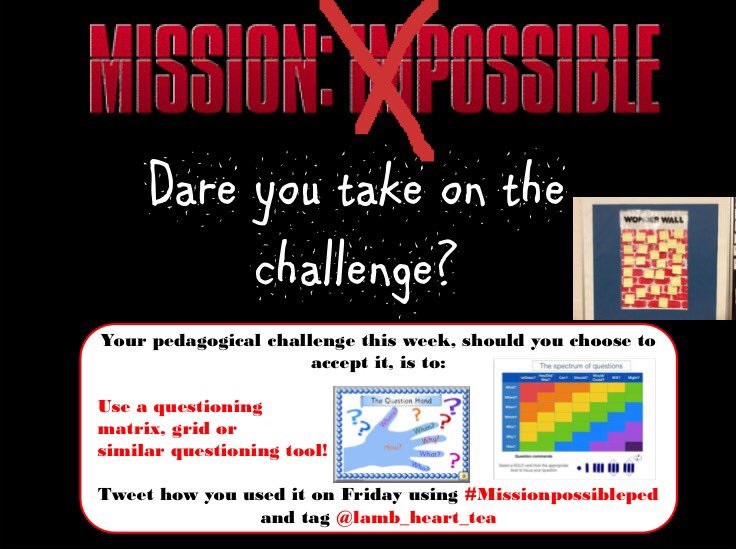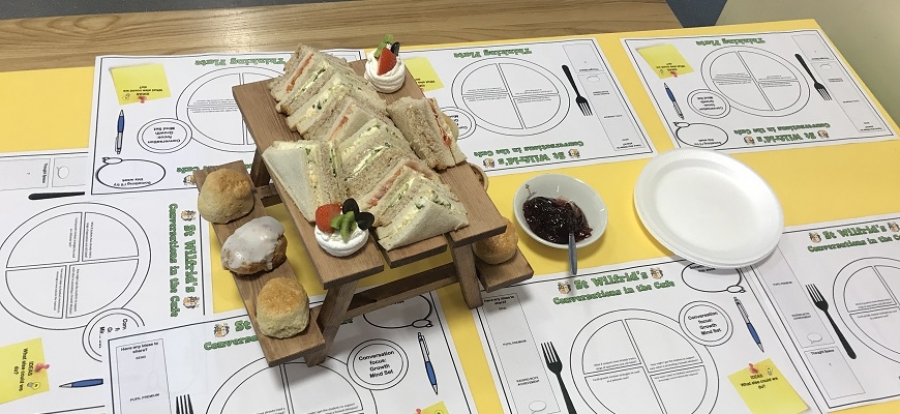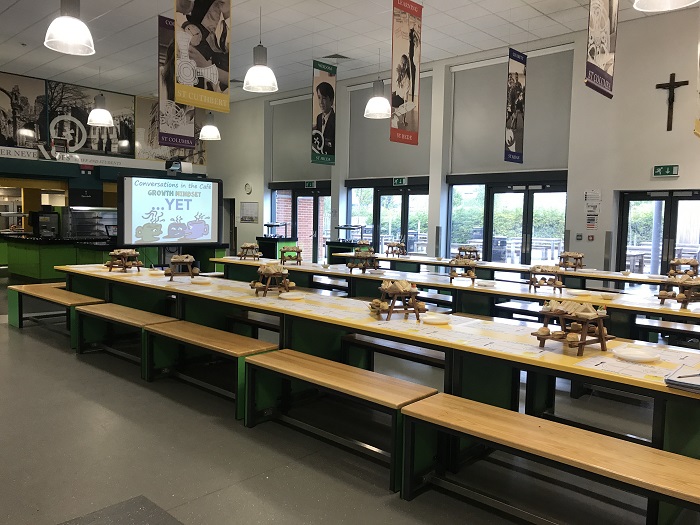Creating a culture of resilience and spontaneity
In tandem with the new specifications, there has never been a better time to re-familiarise or reinvent prior schemes of learning as well as innovate. As part of that, one way to become comfortable with this is by challenging yourself to be resilient and creative. At my school we currently use one voluntary CPD strategy (Mission Possible), and this year will we will be introducing our second (Conversations in the Café – Sharing Good Practice).
Mission Possible: Mission Possible is a voluntary CPD strategy that I introduced into the school in order to support innovative and creative teaching & learning. The idea is to respond to an instant stimulus or idea that could change your norm. An item, a resource, a piece of research or a general strategy is introduced at the start of the month as a challenge. Within the month, colleagues incorporate this mission into their teaching and learning practice. Ideas are then shared amongst staff at the end of each month.
This year we are even turning it into a departmental competition! The outcome is a culture of willingness to step away from the routine and reassuring, instead rethinking, be challenged and either dig out a forgotten resource, amend a resource or create something new. Sharing those ideas then enables us to share good practice with one another by having a monthly wave of effective strategies to be magpied. I will also be issuing these challenges on Twitter via @MissionPed, so please do get involved if you’re wanting to take up the challenge yourself!

From April 2016
Conversations in the Café: This CPD is based upon the value of dialogue amongst colleagues. How often have we passed peers in the corridor and mentioned something about a particular student that you “The idea is to respond to an instant stimulus or idea that could change your norm.”have in common? In the staff room, perhaps you’ve sat next to a colleague marking and loved how efficiently they seem to be whizzing through marking mock examination papers? Professional dialogue, both formal and informal, help us to find missing pieces to a shared jigsaw and strategise effectively by sharing information. Conversations in the Café happen at different points in the year where colleagues come together and discuss questions on a particular focus - for example, November mock examinations outcomes or growth mindset.
With that focus at the core, conversations are facilitated by questions: pre-generated by staff suggestions at prior CPD, and common questions that emerge across the whole school. Staff them sit with peers, from other departments or teams across the school, and discuss those questions. The result is a sharing of information, recognition of commonalities, collaboration and strategizing which can help to inform next steps and interventions. Our aim with this is to come together as a staff and informally share our good practice over an afternoon tea spread and share knowledge as a community. From those conversations we hope that creative ideas, strategies, potential answers (here’s hoping!) to questions and problems will flourish alongside an ethos of a collaborative community.
Ownership and awareness of their own learning
There is a lot of research to support the value of students having ownership over their own learning. Many strategies and resources have been created in order to support this philosophy within our students; ones that help them become responsible, aware people who can take control of their learning and have confidence in knowing where they are currently at in their learning journey. I currently use three different strategies. They are by no means new or unique to me, but I have been using them ever since I began teaching, and I have yet to see them not benefit the teaching and learning which happens within my classroom.
Module/Topic Tick Lists – there are many different versions of this idea that differing practitioners can use and amend to suit their own contexts. The resource that I’ve chosen to create (available here) pulls together the various threads that enable my students to take ownership of their learning. It gives them confidence in knowing for themselves how this particular module or topic is designed and their assessment within it. There are four strands to the KS3 resource:
1. Progress: the lesson topic within the module (attendance, absence and confidence can be self-assessed).
2. Assessment: self-tracking of assessment marks for each of the skills within that unit, as well as our marking code criteria, which is also levelled. There is a target for presentation here, which can be self or teacher-directed.
3. Reflection: Goal setting at the start, middle and end of the module. This enables the student to reflect upon their learning, identify their own interventions for the next module and also take the time to self-realise the lesson where they made their best progress.
4. Connect: This is where potential careers linked to this unit are discussed. To add purpose to their learning, to develop interest within the subject, to encourage understanding of cross-curricular skills and to raise aspirations, I added in the different careers that this module or unit will enable. A key outcome of this has been that students, who may not want to study this subject in the future and therefore disengage from it, instead see the transferability of the skills applied during the lesson and how this can instead facilitate careers and subjects they are more interested in, helping to re-engage them.
Coded marking – This is also identified on the Module/Topic tick lists. I mark students’ work by adding codes into the margin, for example: ‘P’ – there is evidence of a point, ‘EV’ – evidence has been “Students see the transferability of the skills applied during the lesson.”applied. The use of a question mark after the code denotes that criteria that is missing. This enables me to mark students’ work efficiently and with purpose – it’s clear what is there and what is not, identifying visually and easily the areas of progress and areas in need of intervention. The students are aware of these codes, and they not only use them to interpret teacher feedback on key assessments (and so I quite often don’t even write their WWW and EBI (what went well, even better if) as they use the codes to work that out themselves), but also with self and peer assessment.
The beauty of this is that students can mark work knowing independently what criteria they have and have not applied, and can self-identify and correct areas for improvement. Also, they can take pride in spotting when they’ve remembered to incorporate a prior EBI or higher-level skill. This means that in the face of increased assessments, students are involved with us and become the markers themselves, rather than the receivers of feedback which they are not able to understand or action. They are in on the secret themselves! It’s their time to be teacher.
Teacher and student-created examiner assessment feedback reports – for each KS5 assessment or essay, I have a student-friendly feedback form. It this comes with an examiner report created by me (available here), and includes: content that could (and sometimes MUST) have been included, how skills could have been applied, content required for a higher-level response and also a class based series of observations of WWW and EBI across the cohort.
This way, students can see again - very clearly - where criteria has and has not been met. They can also use these to self and peer assess by using the coded marking to mark essays, and then highlight (using different coloured highlighters) the content and skills on the examiner’s report that has and has not been applied.
This creates a very visual illumination of progress for the students. They can see what has been applied, what could have been applied and what should. They allow for students to move forward, using it as well as a revision tool for future purposes. Even better is when the students themselves are given an essay question each and asked to make an ‘Examiner’s Feedback Report’ for the class. This way, they think carefully about what content is relevant, required and meaningful. By placing themselves in the role of the person assessing them, they become more aware of what they need to do – by doing it themselves. Terrifyingly, some of them are better than the ones I create!
Want to receive cutting-edge insights from leading educators each week? Sign up to our Community Update and be part of the action!



















